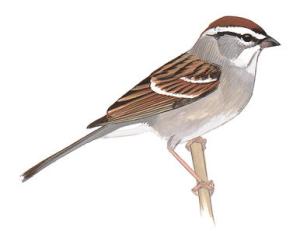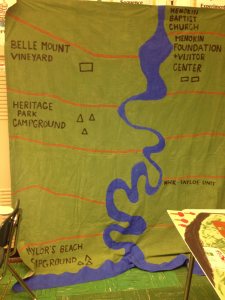The window in my office frames a beautiful view of Menokin. The native plants and shrubs around the visitor’s center bring me a constant and varied cast of feathered guests.
There are the regulars – Eastern bluebirds, goldfinches, hummingbirds, vireos. I more than occasionally spot wild turkeys and bald eagles grazing and hunting in the fields beyond the yard. Some rarer appearances have been made by migrating songbirds – scarlet and summer tanagers, rose-breasted grosbeaks and orioles.
What I don’t see – and this may come as a surprise to you – are pigeons. We just don’t have them in these parts. Doves, yes. Pigeons, not so much.
So imagine my surprise when a movement outside my window caught my eye recently and I looked out to see a pigeon pecking in the mulch under my window.
“Odd,” I thought. “That looks like a pigeon.”
 Just then, a board member, stopping in for a meeting, came through the front door and asked if we were keeping pigeons as pets. “There’s a tagged pigeon wandering around right outside,” he said. “Does he belong to one of you?”
Just then, a board member, stopping in for a meeting, came through the front door and asked if we were keeping pigeons as pets. “There’s a tagged pigeon wandering around right outside,” he said. “Does he belong to one of you?”
And, because of the aforementioned scarcity of pigeons, and the fact that we are The Intrepid Menokin Ladies, we leapt into action. Well, Mavora did. After heading outside to see the pigeon for herself, she made a call to a local wildlife rescue service to report in.
“Oh, that’s probably a racing pigeon,” she was informed. “They’re very used to being around people. Just take a box outside and he’ll walk right into it. Then bring him to us and we’ll take it from there.”
 Wrong. The pigeon, while not apparently alarmed by our proximity (by this time, I had joined the adventure), kept a healthy and stealthy distance from any semblance of cardboard and/or would-be captors. At one point he even flew up onto the barn roof, alleviating our fears that perhaps he was injured.
Wrong. The pigeon, while not apparently alarmed by our proximity (by this time, I had joined the adventure), kept a healthy and stealthy distance from any semblance of cardboard and/or would-be captors. At one point he even flew up onto the barn roof, alleviating our fears that perhaps he was injured.
We ditched the box idea and came back inside. By now it had been a few hours since the discovery of the pigeon’s arrival and we figured he was  probably hungry and thirsty. We grabbed a box of Cream of Wheat and filled a bowl of water and went out to tend our flock of one. After hunting around we finally found him roosting in the lean-to on some of the large dress stones from the house (it must be a pigeon thing). He seemed mildly annoyed that we had discovered his hideout, but did allow Mavora to eventually get close enough to read the letters and numbers on the tag on his leg.
probably hungry and thirsty. We grabbed a box of Cream of Wheat and filled a bowl of water and went out to tend our flock of one. After hunting around we finally found him roosting in the lean-to on some of the large dress stones from the house (it must be a pigeon thing). He seemed mildly annoyed that we had discovered his hideout, but did allow Mavora to eventually get close enough to read the letters and numbers on the tag on his leg.
Leaving him to his meal we went back inside and did what all ingenious preservationists and conservationists do – we googled “Lost Racing Pigeons.” Bingo. Up came the website with all kinds of information about racing pigeons. I garnered a brief but thorough educational insight into the sport, then wrote down the phone number and gave it a call.
I don’t know why I expected the person who answered to be amazed that we had a misplaced racing pigeon. She wasn’t. It was probably her 168th missing pigeon report of the day. Upon entering our pigeon’s tag information into her database, she was able to tell us (in a voice reserved for reading the ingredients on a Cream of Wheat box) where the pigeon was from (Maryland), which club he belonged to, and the name and phone number of the club’s president.
 I was in awe that there is a whole PIGEON NETWORK out there, flying all around us, that I had never been aware of until then. It inspired me to go outside and sit with the pigeon, who continued to keep a safe distance, and tell him all about Menokin and the Northern Neck.
I was in awe that there is a whole PIGEON NETWORK out there, flying all around us, that I had never been aware of until then. It inspired me to go outside and sit with the pigeon, who continued to keep a safe distance, and tell him all about Menokin and the Northern Neck.
After awhile he fell asleep and I went home. The next day he was gone. We never got a call back from the club president. It was probably his 168th “we have your pigeon message” of the week. We are certain that our pigeon made his way back to Maryland and told all of the other racing pigeons about the crazy ladies at his last stop who chased him with a box and fed him breakfast cereal. All that fuss over a pigeon?
You betcha.


























































 Just then, a board member, stopping in for a meeting, came through the front door and asked if we were keeping pigeons as pets. “There’s a tagged pigeon wandering around right outside,” he said. “Does he belong to one of you?”
Just then, a board member, stopping in for a meeting, came through the front door and asked if we were keeping pigeons as pets. “There’s a tagged pigeon wandering around right outside,” he said. “Does he belong to one of you?” Wrong. The pigeon, while not apparently alarmed by our proximity (by this time, I had joined the adventure), kept a healthy and stealthy distance from any semblance of cardboard and/or would-be captors. At one point he even flew up onto the barn roof, alleviating our fears that perhaps he was injured.
Wrong. The pigeon, while not apparently alarmed by our proximity (by this time, I had joined the adventure), kept a healthy and stealthy distance from any semblance of cardboard and/or would-be captors. At one point he even flew up onto the barn roof, alleviating our fears that perhaps he was injured. probably hungry and thirsty. We grabbed a box of Cream of Wheat and filled a bowl of water and went out to tend our flock of one. After hunting around we finally found him roosting in the lean-to on some of the large dress stones from the house (it must be a pigeon thing). He seemed mildly annoyed that we had discovered his hideout, but did allow Mavora to eventually get close enough to read the letters and numbers on the tag on his leg.
probably hungry and thirsty. We grabbed a box of Cream of Wheat and filled a bowl of water and went out to tend our flock of one. After hunting around we finally found him roosting in the lean-to on some of the large dress stones from the house (it must be a pigeon thing). He seemed mildly annoyed that we had discovered his hideout, but did allow Mavora to eventually get close enough to read the letters and numbers on the tag on his leg. I was in awe that there is a whole PIGEON NETWORK out there, flying all around us, that I had never been aware of until then. It inspired me to go outside and sit with the pigeon, who continued to keep a safe distance, and tell him all about Menokin and the Northern Neck.
I was in awe that there is a whole PIGEON NETWORK out there, flying all around us, that I had never been aware of until then. It inspired me to go outside and sit with the pigeon, who continued to keep a safe distance, and tell him all about Menokin and the Northern Neck.






 The students of Mrs. Ptucha’s 6th-grade science classes at Richmond County Intermediate School had the opportunity to dive into the Chesapeake Bay Watershed recently – with paint and brushes. The students participated in a Project WET activity, Make-a-Mural.
The students of Mrs. Ptucha’s 6th-grade science classes at Richmond County Intermediate School had the opportunity to dive into the Chesapeake Bay Watershed recently – with paint and brushes. The students participated in a Project WET activity, Make-a-Mural. identify their local watershed and illustrate it, including water resource
identify their local watershed and illustrate it, including water resource 
 the students were then asked to begin on the mural. Using foam core panels, and acrylic paint, each student worked on designated portions of the watershed – air, land and water.
the students were then asked to begin on the mural. Using foam core panels, and acrylic paint, each student worked on designated portions of the watershed – air, land and water. and is hanging in the hallway at the school.
and is hanging in the hallway at the school.

































